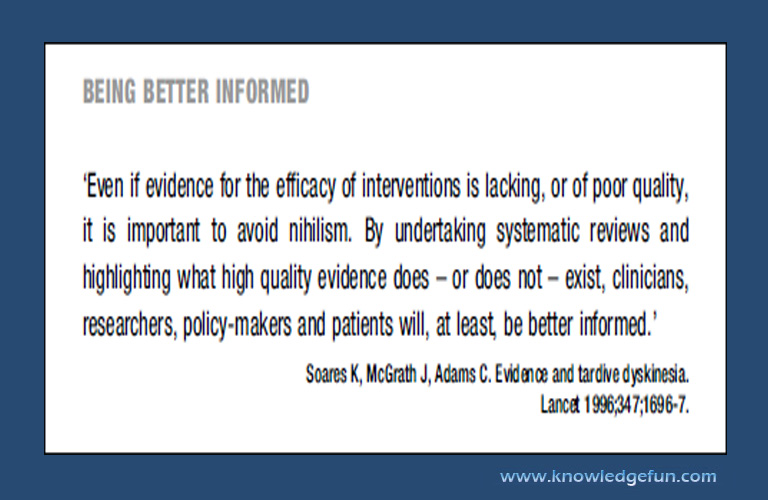Chapter V
CLINICAL RESEARCH: THE GOOD, THE BAD, AND THE UNNECESSARY
Regrettably, research is not always well done or relevant. Take the example of a distressing condition known as tardive dyskinesia. This is a serious side-effect associated with long-term use of drugs called neuroleptics (antipsychotics) which are prescribed for psychiatric disorders, and especially schizophrenia. The most prominent features of tardive dyskinesia are repetitive, involuntary movements of the mouth and face grimacing, lip smacking, frequent poking out of the tongue, and puckering or blowing out of the cheeks. Sometimes this is accompanied by twitching of the hands and feet. One in five patients taking a neuroleptic for more than three months experiences these side-effects.
In the 1990s a group of researchers began exploring, systematically, what treatments had been used for tardive dyskinesia over the preceding 30 years. Writing in 1996, they were rather surprised to have identified about 500 randomised controlled trials involving 90 different drug treatments. Yet none of these trials had produced any useful data. Some of the trials had included too few patients to give any reliable results; in others the treatments had been given so briefly as to be meaningless.
The same research group went on to publish a comprehensive survey of the content and quality of controlled trials relevant to the treatment of schizophrenia in general. They looked at 2,000 trials and were disappointed in what they found. Over the years, drugs have certainly improved the prospects for people with schizophrenia in some respects. For example, most patients can now live at home or in the community. Yet, even in the 1990s (and still today), most drug trials were done on patients in hospital, so their relevance to outpatient treatment is uncertain. On top of that, the inconsistent way in which outcomes of treatment were assessed was astonishing. The researchers discovered that over 600 treatments – mainly drugs but also psychotherapy, for example – were tested in the trials, yet 640 different scales were used to rate the results and 369 of these were used only once. Comparing outcomes of different trials was therefore severely hampered and the results were virtually uninterpretable by doctors or patients. Among a catalogue of other problems, the researchers identified many studies that were too small or short term to give useful results. And new drug treatments were often compared with a drug well known for its side-effects – an obviously unfair test. The authors of this review concluded that half a century of studies of limited quality, duration, and clinical utility left much scope for well-planned, properly conducted, and competently reported trials.

BEING BETTER INFORMED
‘Even if evidence for the efficacy of interventions is lacking, or of poor quality, it is important to avoid nihilism. By undertaking systematic reviews and highlighting what high quality evidence does – or does not – exist, clinicians, researchers, policy-makers and patients will, at least, be better informed.’
Soares K, McGrath J, Adams C. Evidence and tardive dyskinesia.
Lancet 1996;347;1696-7.





